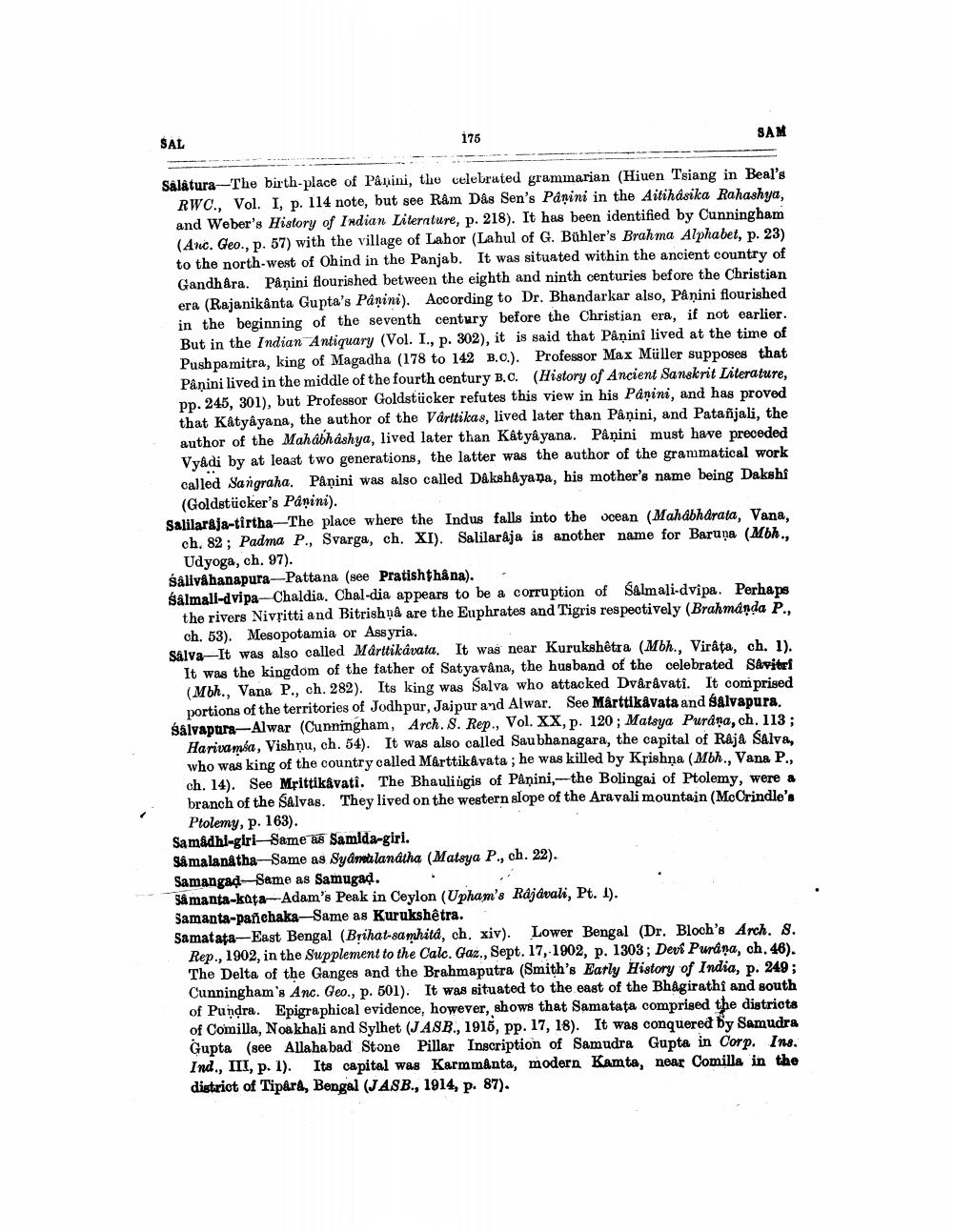________________
SAL
175
SAM
Salatura -The birthplace of Panini, the celebrated grammarian (Hiuen Tsiang in Beal's
RWC., Vol. I, p. 114 note, but see Ram Das Sen's Panini in the Aitihasika Rahashya, and Weber's History of Indian Literature, p. 218). It has been identified by Cunningham (Anc. Geo.. p. 57) with the village of Lahor (Lahul of G. Bühler's Brahma Alphabet, p. 23) to the north-west of Ohind in the Panjab. It was situated within the ancient country of Gandh åra. Påņini flourished between the eighth and ninth centuries before the Christian era (Rajanikânta Gupta's Panini). According to Dr. Bhandarkar also, Panini flourished in the beginning of the seventh century before the Christian era, if not earlier. But in the Indian Antiquary (Vol. I, p. 302), it is said that Panini lived at the time of Push pamitra, king of Magadha (178 to 142 B.C.). Professor Max Müller supposes that Panini lived in the middle of the fourth century B.C. (History of Ancient Sanskrit Literature, pp. 245, 301), but Professor Goldstücker refutes this view in his Panini, and has proved that Katyâyana, the author of the Vårttikas, lived later than Pâņini, and Patañjali, the author of the Mahabhashya, lived later than Katyâyana. Panini must have preceded Vyâdi by at least two generations, the latter was the author of the grammatical work called Sangraha. Panini was also called Dakshaya na, his mother's name being Dakshi
(Goldstücker's Panini). Salilarája-tirtha-The place where the Indus falls into the ocean (Mahabharata, Vana.
ch. 82; Padma P., Svarga, ch. XI). Salilarája is another name for Baruna (Mbh.,
Udyoga, ch. 97). salivahanapura-Pattana (see Pratishthâna). salmall-dvipa-Chaldia. Chal-dia appears to be a corruption of Salm ali-dvipa. Perhaps the rivers Nivritti and Bitrishņå are the Euphrates and Tigris respectively (Brahmanda P..
ch. 53). Mesopotamia or Assyria. salva-It was also called Marttikávata. It was near Kurukshetra (Mbh.. Virâta. ch. 1).
It was the kingdom of the father of Satyavana, the husband of the celebrated Savitri (Mbh., Vana P., ch. 282). Its king was Salva who attacked Dvârâvati. It comprised
portions of the territories of Jodhpur, Jaipur and Alwar. See Mârttikávata and Salvapura. Salvapura-Alwar (Cunningham, Arch. 8. Rep., Vol. XX, p. 120; Matsya Purana, ch. 113;
Harivamsa, Vishnu, ch. 54). It was also called Saubhanagara, the capital of Raja Salva, who was king of the country called Marttikâvata; he was killed by Krishna (Mbh., Vana P., ch. 14). See Mrittikavati. The Bhauliigis of Panini,--the Bolingai of Ptolemy, were a branch of the Salvas. They lived on the western slope of the Aravali mountain (MoCrindle's
Ptolemy, p. 163) Samadhl-giri-Same as Samida-giri. Så malanatha-Same as Syamalanátha (Matsya P., ch. 22). Samangad-Same as Samugad. . Samanta-kata-Adam's Peak in Ceylon (Upham's Rajavali, Pt. 1). Samanta-panchaka-Same as Kurukshetra. Samatata-East Bengal (Brihat-samhita, ch. xiv). Lower Bengal (Dr. Bloch's Arch. s. Rep., 1902, in the Supplement to the Calc. Gaz., Sept. 17,-1902, p. 1303 ; Devi Purana, ch.46). The Delta of the Ganges and the Brahmaputra (Smith's Early History of India, p. 249; Cunningham's Anc. Geo., p. 501). It was situated to the east of the Bhagirathi and south of Pundra. Epigraphical evidence, however, shows that Samatata comprised the districts of Comilla, Noakhali and Sylhet (JASB., 1916, pp. 17, 18). It was conquered by Samudra Gupta (see Allahabad Stone Pillar Inscription of Samudra Gupta in Corp. Ins. Ind., III, p. 1). Its capital was Karmmánta, modern Kamta, near Comilla in the district of Tipara, Bengal (JASB., 1914, p. 87).




